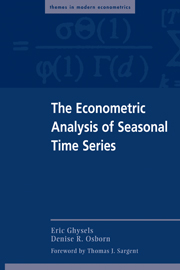Book contents
- Frontmatter
- Contents
- Foreword by Thomas J. Sargent
- Preface
- List of Symbols and Notations
- 1 Introduction to Seasonal Processes
- 2 Deterministic Seasonality
- 3 Seasonal Unit Root Processes
- 4 Seasonal Adjustment Programs
- 5 Estimation and Hypothesis Testing with Unfiltered and Filtered Data
- 6 Periodic Processes
- 7 Some Nonlinear Seasonal Models
- Epilogue
- Bibliography
- Subject Index
- Author Index
4 - Seasonal Adjustment Programs
Published online by Cambridge University Press: 05 June 2012
- Frontmatter
- Contents
- Foreword by Thomas J. Sargent
- Preface
- List of Symbols and Notations
- 1 Introduction to Seasonal Processes
- 2 Deterministic Seasonality
- 3 Seasonal Unit Root Processes
- 4 Seasonal Adjustment Programs
- 5 Estimation and Hypothesis Testing with Unfiltered and Filtered Data
- 6 Periodic Processes
- 7 Some Nonlinear Seasonal Models
- Epilogue
- Bibliography
- Subject Index
- Author Index
Summary
Introduction
Statistical agencies around the globe engage in a process called seasonal adjustment. Roughly speaking, this amounts to filtering raw data such that seasonal fluctuations disappear from the series. Neither the principle nor its practical implementation is simple. Many resources are constantly devoted to the design of seasonal adjustment procedures. It is a subject of perpetual debate, sometimes even involving heads of state. Most statistical agencies use fairly standardized procedures. The U.S. Census Bureau X-l 1 method and its recent upgrade, the X-12-ARIMA program, are the most widely used. A competing procedure, called TRAMO/SEATS, was developed by Agustin Maravall of the Bank of Spain. There are also other programs besides X-l2 and TRAMO/SEATS, such as the procedure in Andrew Harvey's STAMP program. We will cover those in less detail, as the bulk of seasonal adjustments use either one of the two leading programs we discuss in this chapter.
The chapter is divided into five sections. The first discusses decompositions, followed by three sections devoted to the X-ll, X-12-ARIMA, and TRAMO/SEATS procedures, respectively. The final section covers the subject of seasonal adjustment and other transformations.
Decompositions
Observed economic time series can be decomposed in several mutually orthogonal unobserved components. As we noted in Chapter 1, there is a long tradition dating back to the 19th Century of unobserved component models.
- Type
- Chapter
- Information
- The Econometric Analysis of Seasonal Time Series , pp. 93 - 120Publisher: Cambridge University PressPrint publication year: 2001

